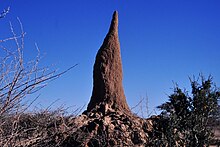Termitomyces schimperi
| Termitomyces schimperi | ||||||||||||
|---|---|---|---|---|---|---|---|---|---|---|---|---|

Termitomyces schimperi |
||||||||||||
| Systematics | ||||||||||||
|
||||||||||||
| Scientific name | ||||||||||||
| Termitomyces schimperi | ||||||||||||
| ( Pat. ) R. Heim |
Termitomyces schimperi is a predominantly with the termite Macrotermes natalensis socialized Agaric . The majority of the mushroom is referred to by the Namibian tribes Herero and Ovambo as "Omajowa" (other spellings: "Omajova" or "Omayova"). The German Namibians usually simply call it "termite mushroom".
features
The hat is "the size of a man's fist" when unopened. It shields quickly and then measures 15–28 cm in width. Stately specimens reach a diameter of up to 40 cm. The hat and the thick, soft scales are white and can be yellowish to reddish-brown in color due to the soil on the termite mound . The scales are mostly uncolored white under their outermost layer. The root-like extension of the stem base (pseudorhiza) has its origin in the termite nest and can reach a length of about 90 cm. The lower, narrower part of the pseudorhiza has a denser consistency than the above-ground part.
Ecology and phenology
Termitomyces schimperi does not appear on all termite mounds . The fungus is found only on the high hills of central and northern Namibia, where the average rainfall is 350 mm or more. These hills are often 4–5 m high and always lean to the north at the top.
The species has been identified from mounds of the termite species Macrotermes natalensis , further information relates to Macrotermes subhyalinus , Odontotermes patruus and possibly other termite species.
Termite fungi usually show up after the soaking rain of 12 mm or more in spring, predominantly in the main rainy season from January to March. The fruiting bodies grow in groups of 5 to 10 around the lower areas of the termite mounds and grow about 50 cm above the ground. Up to 50 fruit bodies have already been observed on a single hill. Fruit bodies can grow out of the same termite mound in several years.
distribution
In Namibia, occurrences of termite fungus from the areas around Omaruru , Okahandja , Otjiwarongo , Grootfontein , Tsumkwe , the east of Windhoek and the southern part of the Etosha National Park are known.
meaning
Edible mushroom
Omajowa are not bred. As soon as it has rained, the fruiting bodies have to be harvested early, as they are also eaten by numerous animals such as warthogs . During the season the mushrooms are sold in supermarkets and on the roadsides. The termite mushrooms can be frozen well and are often preserved in this way for future consumption. The termite mushroom is usually fried as a food. It can also be used as a vegetable side dish in soups, risottos and sauces. Because of its large size, the mushroom is sometimes even made as a steak by locals.
philately
In 1999, Nampost issued a N $ 5.50 postage stamp depicting a single Ejova fruiting body.
Others
The mushroom is seen as a symbol of growth and prosperity.
Individual evidence
- ↑ a b c d Gideon Christiaan Albertus van der Westhuizen, Albert Eicker: The 'omajowa' or 'termitenpilz' termitomyces sp. (agaricales) of Namibia . In: South African Journal Of Botany . tape 57 , no. 1 , 1991, p. 67-70 .
- ^ TG Wood, RJ Thomas: The mutualistic association between Macrotermitinae and Termitomyces . In: Insect-Fungus Interactions. Symposium of the Royal Entomological Society . tape 14 . Academic Press, 2012, ISBN 0-08-098453-3 , pp. 77 (344 pages).
- ↑ Annabelle Venter: The inimitable omajowa - Namibia's giant, wild, edible mushroom. In: Travel News Namibia . December 21, 2012, accessed August 12, 2013 .
- ↑ Omajova - A wild Delicacy. In: GondwanaCollection, Stamps & Stories . January 20, 2013, accessed August 12, 2013 .
- ↑ Ozondjahe Hunting Safaris: Omajowa, Termite Hill Mushrooms in Namibia. In: AfricaHunting.com . May 6, 2013, accessed August 12, 2013 .
